-
 Bitcoin
Bitcoin $107,725.9156
0.27% -
 Ethereum
Ethereum $2,481.6786
1.84% -
 Tether USDt
Tether USDt $1.0003
0.01% -
 XRP
XRP $2.2154
1.26% -
 BNB
BNB $658.2447
1.42% -
 Solana
Solana $157.2028
4.24% -
 USDC
USDC $1.0000
0.02% -
 TRON
TRON $0.2788
0.91% -
 Dogecoin
Dogecoin $0.1655
1.00% -
 Cardano
Cardano $0.5714
2.67% -
 Hyperliquid
Hyperliquid $40.6187
6.30% -
 Bitcoin Cash
Bitcoin Cash $519.8117
5.84% -
 Sui
Sui $2.8338
0.59% -
 Chainlink
Chainlink $13.4150
0.60% -
 UNUS SED LEO
UNUS SED LEO $9.1205
-0.54% -
 Avalanche
Avalanche $18.0666
0.85% -
 Stellar
Stellar $0.2363
-0.46% -
 Toncoin
Toncoin $2.9550
2.57% -
 Shiba Inu
Shiba Inu $0.0...01151
-0.15% -
 Litecoin
Litecoin $86.2252
-0.57% -
 Hedera
Hedera $0.1498
1.51% -
 Monero
Monero $318.0620
3.18% -
 Polkadot
Polkadot $3.4174
-0.02% -
 Dai
Dai $1.0000
0.02% -
 Bitget Token
Bitget Token $4.5444
-1.05% -
 Ethena USDe
Ethena USDe $1.0003
0.00% -
 Uniswap
Uniswap $7.1773
-0.53% -
 Pepe
Pepe $0.0...09916
3.19% -
 Aave
Aave $274.7399
0.32% -
 Pi
Pi $0.5136
-2.06%
How to predict the direction in advance after the shrinking volume and sideways shock?
Shrinking volume and sideways shock in crypto signal uncertainty, requiring traders to monitor order books, on-chain data, and technical indicators like Bollinger Bands for potential breakouts.
Jun 30, 2025 at 08:57 pm
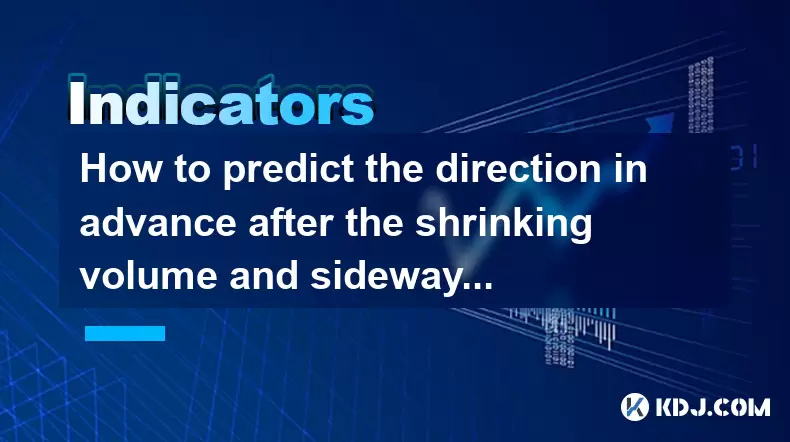
Understanding Shrinking Volume and Sideways Shock
In the cryptocurrency market, shrinking volume refers to a period where trading activity significantly decreases. This often indicates a lack of interest or uncertainty among traders regarding the next price movement. Simultaneously, sideways shock occurs when the price moves within a narrow range without showing any clear upward or downward trend. When these two phenomena happen together, it can be challenging for traders to determine whether a breakout is imminent or if consolidation will continue.
Shrinking volume during sideways movement suggests that neither bulls nor bears are in control. It’s crucial to monitor order books and on-chain metrics to understand potential accumulation or distribution patterns.
Technical Indicators That Can Help Predict the Direction
To anticipate the direction after shrinking volume and sideways movement, several technical indicators can be used effectively:
- Bollinger Bands: These help identify periods of low volatility. A contraction in Bollinger Bands often precedes a significant move.
- Volume Profile: Analyzing volume at price levels helps detect areas of value where large orders might be placed.
- Order Block Analysis: Identifying institutional-level imbalances can give insight into potential reversal points.
- Moving Averages (MA): While not always reliable in ranging markets, crossovers or breakdowns near key MAs can signal new trends.
It's essential to combine multiple tools rather than relying on a single indicator. The confluence of signals increases reliability when predicting breakouts.
On-Chain Metrics and Market Sentiment Analysis
Beyond traditional technical analysis, on-chain data provides deeper insights into market structure:
- Exchange Netflow: Monitoring inflows and outflows from exchanges can indicate whether whales are accumulating or distributing.
- Holders Trend: A rising number of long-term holders may suggest underlying strength despite sideways action.
- MVRV Ratio: Helps assess whether an asset is overvalued or undervalued based on realized capitalization.
Market sentiment derived from social media and news platforms should also be considered. Tools like Google Trends or crypto-specific sentiment analysis platforms offer early warning signs about potential shifts.
Price Action Patterns During Low Volatility Phases
During periods of shrinking volume and sideways movement, certain candlestick patterns may emerge that hint at future direction:
- Inside Bars: Often appear during consolidations and may lead to explosive moves once broken.
- Triangle Formations: Especially symmetrical triangles, which typically resolve with strong directional momentum.
- Key Level Tests: Repeated rejections at support or resistance levels can foreshadow a breakout.
Traders should mark critical psychological and historical levels. Watching how price reacts near those zones during low volume phases is crucial for anticipating moves.
Risk Management and Entry Strategies
Even with strong predictive signals, entering a trade without proper risk management can lead to losses:
- Set Stop-Loss Orders: Placing stop-loss just beyond the consolidation zone helps protect against false breakouts.
- Use Position Sizing: Allocate only a small portion of your portfolio to trades during uncertain conditions.
- Wait for Confirmation: Don’t rush into a trade immediately after a breakout; wait for a pullback or retest for better entry points.
Patience and discipline are vital when navigating low-volume consolidations. Avoid chasing breakouts without confirmation from volume or other confirming indicators.
Frequently Asked Questions
Q: How long can a sideways market last in crypto?
A: In cryptocurrency, sideways movements can last from a few hours to several weeks depending on broader market sentiment, macroeconomic events, and exchange inflows/outflows.
Q: Does shrinking volume always lead to a breakout?
A: No. Shrinking volume can also indicate prolonged consolidation or even a slow downtrend if there's continuous selling pressure masked by low activity.
Q: What timeframes are best for analyzing shrinking volume and sideways movement?
A: Higher timeframes like 4-hour or daily charts provide more reliable signals compared to shorter intervals where noise dominates.
Q: Should I avoid trading during shrinking volume and sideways movement?
A: Not necessarily. These phases offer opportunities for advanced traders who use volume profile, order block analysis, and patience to enter high-probability setups.
Disclaimer:info@kdj.com
The information provided is not trading advice. kdj.com does not assume any responsibility for any investments made based on the information provided in this article. Cryptocurrencies are highly volatile and it is highly recommended that you invest with caution after thorough research!
If you believe that the content used on this website infringes your copyright, please contact us immediately (info@kdj.com) and we will delete it promptly.
- Coinbase, Altcoins, and Listings: What's the Buzz?
- 2025-07-01 00:30:11
- Chainlink's Bullish Signals: Investors Bet on Long-Term Value
- 2025-07-01 00:50:12
- CICADA Finance Soars on BNB Chain: A TGE Deep Dive
- 2025-07-01 01:30:11
- MicroStrategy's Bitcoin Bet: Holdings, Sell-Off Concerns, and S&P 500 Dreams
- 2025-07-01 01:30:11
- XRPL EVM Sidechain: Ethereum dApps Unleashed on XRP Ledger!
- 2025-07-01 01:35:11
- Bybit, Kraken, and Tokenized Stocks: A New Era for Trading?
- 2025-07-01 00:30:11
Related knowledge
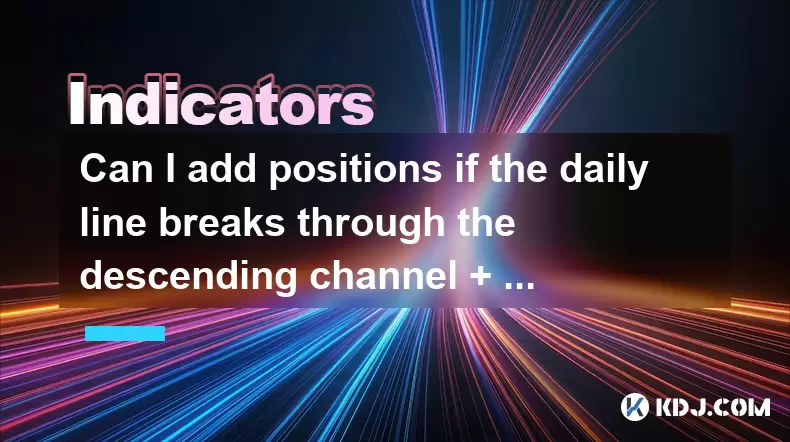
Can I add positions if the daily line breaks through the descending channel + the 30-minute moving average is in a bullish arrangement?
Jun 30,2025 at 11:00pm
Understanding the Descending Channel BreakoutWhen a daily line breaks through a descending channel, it indicates a potential shift in market sentiment from bearish to bullish. A descending channel is formed by drawing two parallel trendlines, where the upper trendline connects the lower highs and the lower trendline connects the lower lows. A breakout o...
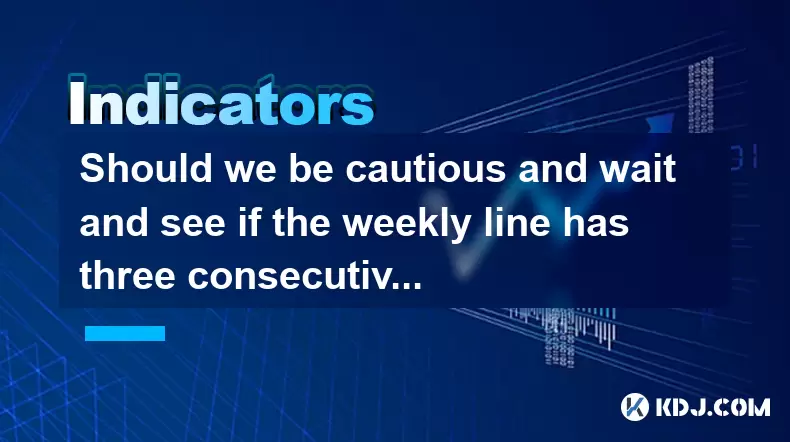
Should we be cautious and wait and see if the weekly line has three consecutive Yin lines + the daily MACD green column enlarges?
Jul 01,2025 at 12:42am
Understanding the Weekly Three Consecutive Yin Lines PatternIn technical analysis, three consecutive Yin lines on a weekly chart indicate a strong bearish trend. Each Yin line represents a week where the closing price is lower than the opening price, signaling consistent selling pressure. When this pattern appears three times in succession, it often sug...
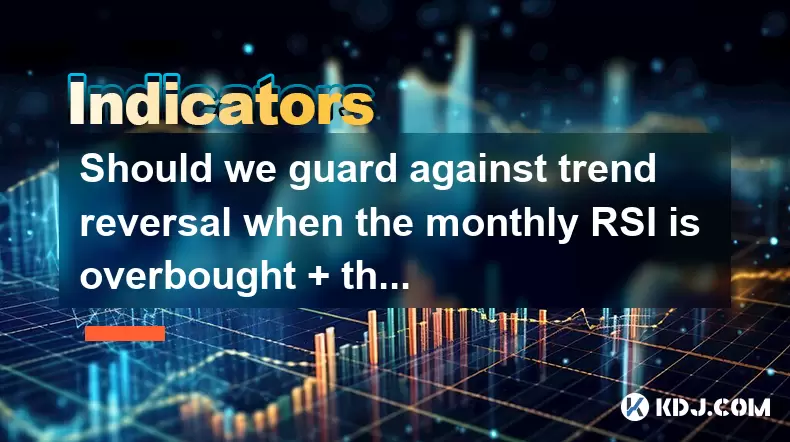
Should we guard against trend reversal when the monthly RSI is overbought + the weekly line has a long upper shadow?
Jun 30,2025 at 11:35pm
Understanding RSI Overbought Conditions in CryptocurrencyThe Relative Strength Index (RSI) is a momentum oscillator commonly used in technical analysis to identify overbought or oversold conditions in an asset. When the monthly RSI of a cryptocurrency reaches above 70, it is generally considered overbought, suggesting that the asset may be due for a pul...
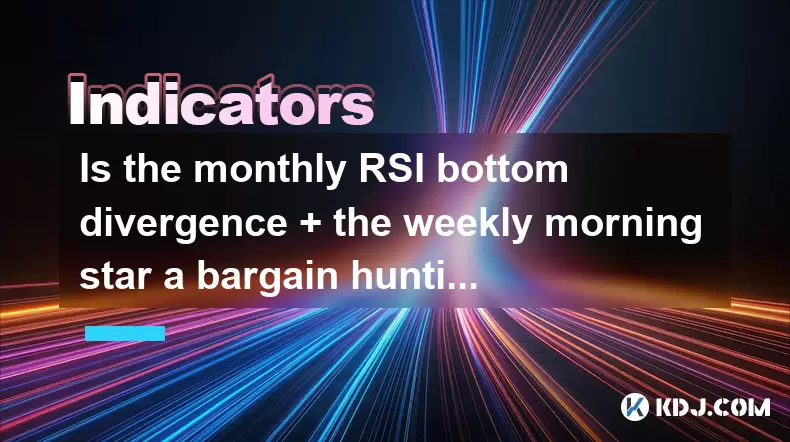
Is the monthly RSI bottom divergence + the weekly morning star a bargain hunting opportunity?
Jun 30,2025 at 09:57pm
Understanding RSI Bottom Divergence in Monthly TimeframesThe Relative Strength Index (RSI) is a momentum oscillator commonly used to identify overbought or oversold conditions in the market. When traders refer to a monthly RSI bottom divergence, they're observing a situation where the price makes a lower low, but the RSI makes a higher low on the monthl...
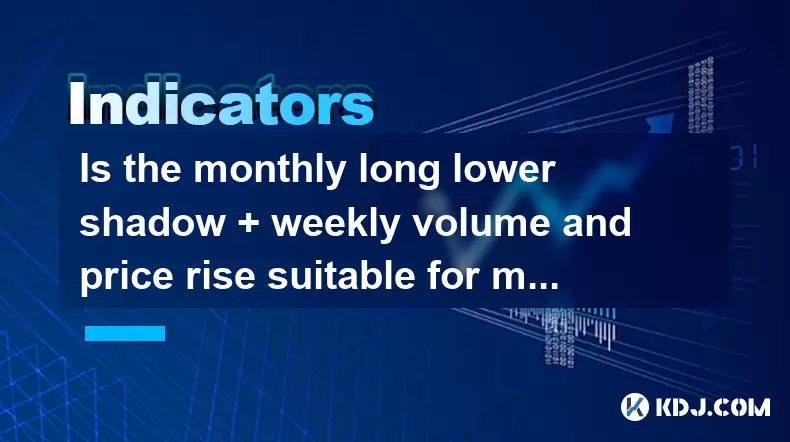
Is the monthly long lower shadow + weekly volume and price rise suitable for mid-term layout?
Jul 01,2025 at 01:29am
Understanding the Monthly Long Lower Shadow PatternA monthly long lower shadow candlestick pattern occurs when the price of a cryptocurrency drops significantly during the month but then rebounds to close near or above the opening price. This creates a candle with a long wick below and a relatively small body. In technical analysis, this pattern is ofte...
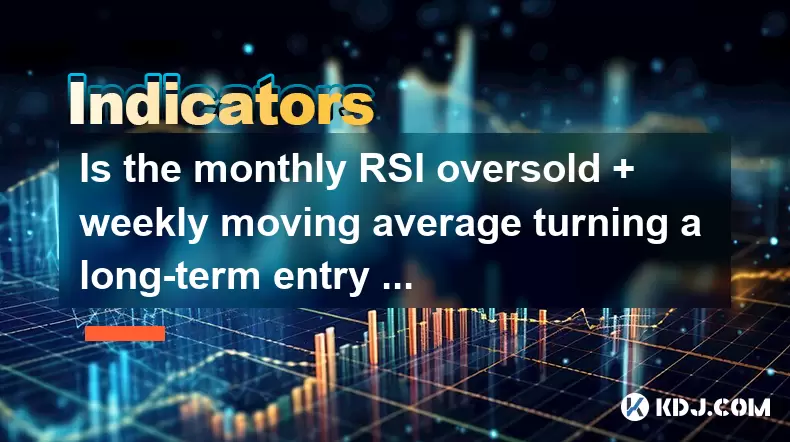
Is the monthly RSI oversold + weekly moving average turning a long-term entry signal?
Jun 30,2025 at 11:42pm
Understanding RSI and Its Role in Cryptocurrency TradingThe Relative Strength Index (RSI) is a momentum oscillator commonly used by traders to identify overbought or oversold conditions in the market. In the context of cryptocurrency, where volatility reigns supreme, understanding how RSI behaves on different timeframes becomes crucial. When the monthly...

Can I add positions if the daily line breaks through the descending channel + the 30-minute moving average is in a bullish arrangement?
Jun 30,2025 at 11:00pm
Understanding the Descending Channel BreakoutWhen a daily line breaks through a descending channel, it indicates a potential shift in market sentiment from bearish to bullish. A descending channel is formed by drawing two parallel trendlines, where the upper trendline connects the lower highs and the lower trendline connects the lower lows. A breakout o...

Should we be cautious and wait and see if the weekly line has three consecutive Yin lines + the daily MACD green column enlarges?
Jul 01,2025 at 12:42am
Understanding the Weekly Three Consecutive Yin Lines PatternIn technical analysis, three consecutive Yin lines on a weekly chart indicate a strong bearish trend. Each Yin line represents a week where the closing price is lower than the opening price, signaling consistent selling pressure. When this pattern appears three times in succession, it often sug...

Should we guard against trend reversal when the monthly RSI is overbought + the weekly line has a long upper shadow?
Jun 30,2025 at 11:35pm
Understanding RSI Overbought Conditions in CryptocurrencyThe Relative Strength Index (RSI) is a momentum oscillator commonly used in technical analysis to identify overbought or oversold conditions in an asset. When the monthly RSI of a cryptocurrency reaches above 70, it is generally considered overbought, suggesting that the asset may be due for a pul...

Is the monthly RSI bottom divergence + the weekly morning star a bargain hunting opportunity?
Jun 30,2025 at 09:57pm
Understanding RSI Bottom Divergence in Monthly TimeframesThe Relative Strength Index (RSI) is a momentum oscillator commonly used to identify overbought or oversold conditions in the market. When traders refer to a monthly RSI bottom divergence, they're observing a situation where the price makes a lower low, but the RSI makes a higher low on the monthl...

Is the monthly long lower shadow + weekly volume and price rise suitable for mid-term layout?
Jul 01,2025 at 01:29am
Understanding the Monthly Long Lower Shadow PatternA monthly long lower shadow candlestick pattern occurs when the price of a cryptocurrency drops significantly during the month but then rebounds to close near or above the opening price. This creates a candle with a long wick below and a relatively small body. In technical analysis, this pattern is ofte...

Is the monthly RSI oversold + weekly moving average turning a long-term entry signal?
Jun 30,2025 at 11:42pm
Understanding RSI and Its Role in Cryptocurrency TradingThe Relative Strength Index (RSI) is a momentum oscillator commonly used by traders to identify overbought or oversold conditions in the market. In the context of cryptocurrency, where volatility reigns supreme, understanding how RSI behaves on different timeframes becomes crucial. When the monthly...
See all articles

























































































